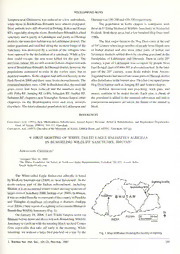
First Sighting of White tailed Eagle Haliaeetus Albicilla in Bumdeling Wildlife Sanctuary, Bhutan PDF
Preview First Sighting of White tailed Eagle Haliaeetus Albicilla in Bumdeling Wildlife Sanctuary, Bhutan
MISCELLANEOUS NOTES Sampora near Ghilamora was reduced to a few individuals, Dhemajiwas 150-200and450-550respectively. while those in Bordoibam-Bilmukh were almost extirpated. The population in Kobo chapori is contiguous with StrayanimalswerestillobservedinDulling,KakoiandRanga thosein D'EringMemorial Wildlife Sanctuary inArunachal RFs,especiallyalongtherivers. Bordoibam-Bilmukhisabird Pradesh. Both theseareas hadafew hundred Flog Deeruntil sanctuary and is partly in Lakhimpur and partly in Dhemaji 1980s. districts;themaindeerhabitatwasinLakhimpurdistrict.The The firstmajorthreattotheHogDeercameattheend entire grasslandandreedbedalongthe westernfringeofthe of19thcenturywhenlargenumberofpeoplefromMajuliarea Sanctuary was destroyed by a section of the villagers who of Jorhat district and also from other parts of Jorhat and were opposed to the declaration ofa sanctuary. While afew Sivasagardistricts settled down by clearing grassland in the deer could escape, the rest were killed for the pot. The floodplains of Lakhimpur and Dhemaji. Then in early 20lh survivors (about20)arestill seeninGohainchaporitowards century, a part ofLakhimpur was occupied by people from westofBordoibam-Bilmukh.InDhemajidistrict,however,the EastBengal;partofPabhoRFisalsoencroached. Inthe later populations continued to exist in the earlier sites, but in part of the 20th century, some Bodo tribals from Assam- depleted numbers. Kobochapori had suffered heavily in the NagalandborderhadmovedintosomepartsofDhemajidistrict flashfloodin2000andtherewerefreshencroachments. The afterdisturbanceintheformerarea.Theyhaveoccupiedprime estimatednumberswere<200. InBordolonialso,thereedand Hog Deerhabitatsuch asJamjingRFandSemen chapori. grass cover had been reduced and the numbers may be Habitat destruction and poaching, with guns and <80, Poba RF, Jamjing RF (<40), Sengajan RF, Jiadhal RF, snares, continue to be major threats. Each year, a chunk of SubansiriRF,chaporiesnearSonarighat,Semenchapori,other the grassland is added to the mustard cultivation and unless chapories on the Brahmaputra river and stray animals conservation measures are taken, the future ofthe animal is elsewhere. The total estimatedpopulation inLakhimpurand bleak. REFERENCES Choudhury, A.U. (1991): New Dhakuakhana Sub-Division. Annual Report. Revenue, Relief & Rehabilitation, and Registration Departments, Govt, ofAssam, 1990-91: 111-117. Guwahati. Choudhury,A.U. (1997): Checklistofthe MammalsofAssam. Gibbon BooksandASTEC, Guwahati. 103 pp. FIRST SIGHTING OF WHITE-TAILED EAGLE HALIAEETUS ALBICIELA 9. IN BUMDELING WILDLIFE SANCTUARY, BHUTAN1 Anwaruddin Choudhury2 'Accepted May 16, 2006 The Rhino Foundation for Nature in North-east India, Bamunimaidam, Guwahati 781 021. Assam, India. Email: [email protected] The White-tailed Eagle Haliaeetus albicilla is listed by BirdLife International (2004) as ‘nearthreatened’. In the north-eastern part of the Indian subcontinent, including Bhutan,itisanoccasionalwintervisitormovingupstreamof largerrivers(Choudhury2000;Inskippetal.2004). InBhutan, itwasrecordedfromthewesternpartofthecountryinPunakha and Thimphu dzongkhags (dzongkhag - district) (Inskipp etal. 2004). IherereportofasightinginfareasternBhutanin BumdelingWildlifeSanctuary(Fig. 1). On January 18, 2006, I left Trashi Yangtze town (in Bhutan)beforedawnanddrovetowardsBumdelingWildlife SanctuarytocatchupwiththeroostingBlack-neckedCranes Grits nigricollis that take off early in the morning. While returning, we noticed a large bird perched on a tree by the Fig. 1: MapofBhutanshowingthelocalityofsighting 1 Bombay Nat. Hist. Soc., 104 (2), May-Aug 2007 209 MISCELLANEOUS NOTES Khulong chu (c/u<=river). Khulong chu is an important Bumdeling Wildlife Sanctuary, and from eastern Bhutan. tributary ofthe Manas river. Initially we thought it to be a Interestingly, thisbirdisknowntomoveuplargerrivers, such large fish-owl, but on observing it through a powerful asthe BrahmaputraandLohit, but Khulongchuisarelatively spotting scope, we identified it as an eagle; the bird flew small river compared to other rivers where the species was away before we could get a closer look. After some time it recordedearlier. Moreover,ithasmovedupfarnorth. perched again on atree. This time we identifiedthe bird, to ACKNOWLEDGEMENTS ouruttersurprise,asthemagnificentadultWhite-tailedEagle. Weobserveditforabout20minutesandalsotooksomestill and video photographs, through the spotting scope. The IthankdashoTsheringWangda,JointSecretary,Home, photos, though taken fromadistanceofatleast250m, were RoyalGovernmentofBhutan,SherubandSharapWangchuk ofgoodquality. Thelocationwasat27°38'20"Nand91°28' of Nature Conservation Division, Mohabbat Shah Ali and 40" E,andtheelevationwas 1,900mabovemsl. ImranMazumdar(Babu)fortheirhelpandsupportduringthe This is the first record of the White-tailed Eagle from visittoBumdelingWildlifeSanctuary. REFE NCES BirdLife International (2004): Threatened Birds of the World. Books and WWF-lndia. 240 pp. CD-ROM.Cambridge,U.K.: BirdLifeInternational. Inskipp.C„T.Inskjpp&R.Grimmett(2004):BirdsofBhutan.Timeless Choudhury,A.U.(2000):TheBirdsofAssam.Guwahati,India:Gibbon Books. New Delhi. 192 pp. SIGHTING OF LARGE NUMBER OF SHORT-TOED EAGLE CIRCAETUS GALLICUS AND 10. GREATER ADJUTANT LEPTOPTILOS DUBIUS IN KAZIRANGA NATIONAL PARK1 Anwaruddin Choudhury2 'Accepted May 17, 2006 :The Rhino Foundation for Nature in North-east India, Bamunimaidam, Guwahati 781 021, Assam, India. Email: [email protected] The Short-toedEagle Circaetusgallicuswasrecorded On the same day. near the junction of the road to for the first time in Assam in Dhakuakhana area in 1991 MethonmarionArimora-Hulalpatroad,50 GreaterAdjutants (Choudhury 1991).Priortothattherewasnoreportfromnorth- Leptoptilosdubiuswere seen flying fromeasttowest. They eastIndia(AliandRipley 1987).Subsequently,itwassighted were seen flying from west ofArimoraand when above the in some more areas like the Nameri National Park (NP), Arimora-Methonmari road, they soared for a while before ChakrashilaSanctuary,KazirangaNP,nearAbhoyapuri.Most flying off towards the east and south-east. Up to the point ofthesightingswereofsinglebirds.OnNovember20,2005, wheretheytooktosoartheycamelikeagroup,butafterwards while driving along the patrol roads in Arimora area of splitintosmallergroupsandindividuals,andflewdownwards Kaziranga NP, accompanied by Dharanidhar Boro, Ranger, (could be observed till tree line blocked view). For IsawaShort-toedEagleperchedonamedium-sizedSilkCotton Dharanidhar Boro also sighting of such large number of Bombax ceiba tree. Before I could attempt to take a GreaterAdjutantsinKazirangawasafirsttime.Themaximum photograph, one more was seen soaring overhead, followed number of Greater Adjutants seen together was 87 resting by another three, all singly. We moved towards the road to duringthedaytimeonthebanksofthe Brahmaputrariveroff BorbeelwheretwowereseenperchedonasingleSilkCotton GuwahaticityonMarch 14, 1994(Choudhury2000).However, tree. We were surprised to see afew more, soaring or flying just after the breeding season, more than 80 birds roost at offfromoneSilkCottontoanother.Thetotaltally,inthesame Islampurkabrstan(26°10'N,91°45'E)intheheartofGuwahati area, was 11 birds. Most of the birds had typical plumage city.TheGreaterAdjutantislistedasendangeredbecauseof with grey head and breast, barred underbody and broad its very small, declining population (BirdLife International sub-terminaltail-band. 2004). REFERENCES An,S.&S.D. Ripley(1987):CompactHandbookoftheBirdsofIndia Choudhury, A.U. (1991): Two new eagles in Assam. Newsletterfor andPakistan.Bombay,India:OxfordUniversityPress.737pp,plates. Birdwatchers 31 (11 & 12): 910. BirdLife International (2004): Threatened Birds of the World. Choudhury,A.U.(2000):TheBirdsofAssam.Guwahati.India:Gibbon CD-ROM.Cambridge, U.K.: BirdLifeInternational. Books and WWF-lndia. 240 pp. 210 J. Bombay Nat. Hist. Soc., 104 (2), May-Aug 2007
